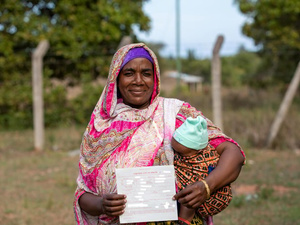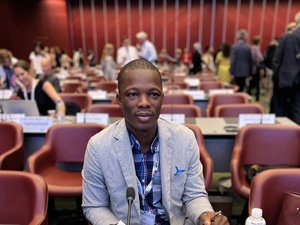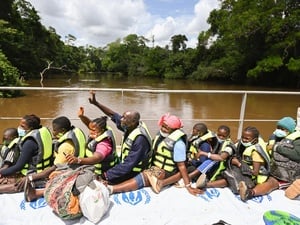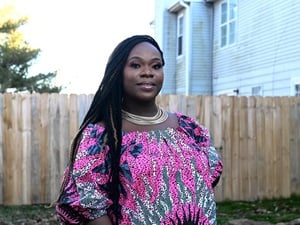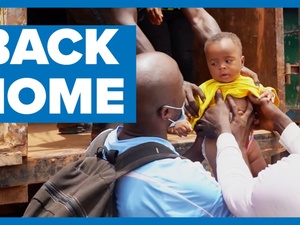Peace prospects pulling West Africa's refugees home
Peace prospects pulling West Africa's refugees home
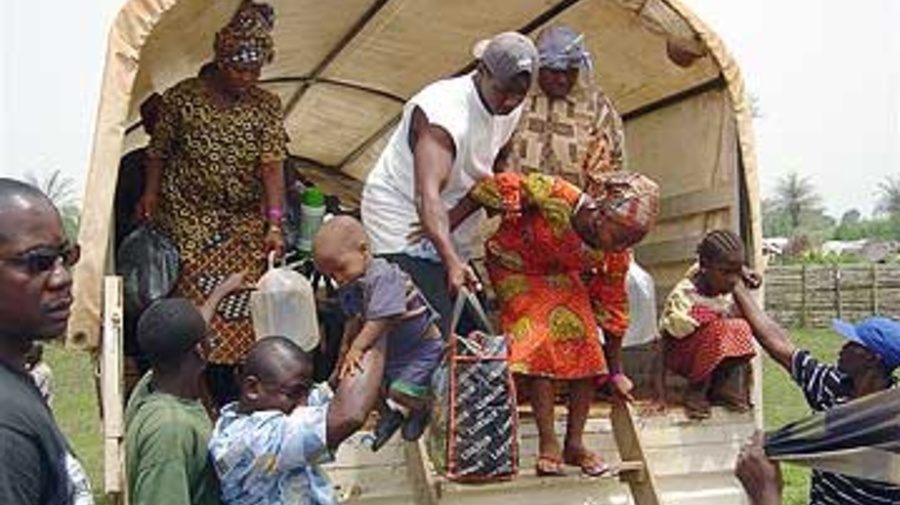
Sierra Leonean returnees arriving at Zimmi waystation after crossing back from Liberia.
ZIMMI, Sierra Leone, March 12 (UNHCR) - After years of civil war, thousands of West Africa's refugees are now streaming home through a recently-opened route between western Liberia and southern Sierra Leone to embrace peace prospects in their homelands.
At a meeting on voluntary repatriation and sustainable reintegration in Africa earlier this week, UNHCR identified Liberia and Sierra Leone as two West African countries where large-scale refugee returns have been or could soon be taking place, in view of ongoing peace initiatives.
So far this month, some 250 Sierra Leonean refugees have been assisted home from Liberia through the Bo Waterside crossing point. UNHCR resumed its voluntary repatriation by land at the beginning of this month when the route was re-opened with the deployment of UNMIL (UN Mission in Liberia) troops to the area inside Liberia bordering Sierra Leone, previously occupied by LURD (Liberians United for Reconciliation and Democracy) rebels.
The latest movement on Tuesday left Monrovia's camps with 124 refugees, many of whom had fled Sierra Leone when the civil conflict first started in 1991. Their children were born in exile and spoke Liberian English, but they never saw Liberia as home and welcomed this new chance to repatriate with UNHCR assistance.
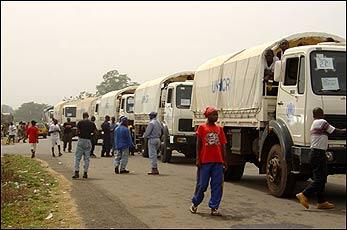
The third UNHCR return convoy from Liberia to Sierra Leone since March 2, 2004.
Among Tuesday's returnees was Musu Koroma, an 83-year-old woman who escaped from Sierra Leone 13 years ago. Despite losing an eye, two children and an unborn grandchild to the war - her daughter was killed by rebels when she was five months pregnant - she still rejoiced at being back "in my home with my people".
"There is no place like home," said another returnee, a young man who had been living in Liberia for eight years.
Arriving at Zimmi waystation in southern Sierra Leone, just across the border from Bo Waterside, returnees were vaccinated against yellow fever and will be quarantined for a week. They will receive food rations like bulgur and oil, and relief items like plastic sheeting and kitchen sets before being transported to their home areas.
The situation in Sierra Leone has stabilised with the end of the 10-year civil war in 2001 and the nationwide deployment of UNAMSIL (UN Mission in Sierra Leone) troops. The government in Freetown has been working with UN and non-governmental agencies to rebuild returnee areas and ensure basic services like potable water, health care and schools.
In a further bid to encourage some of the 12,000 remaining Sierra Leonean refugees in Liberia to go home before the end of the organised repatriation in June, UNHCR has started a campaign to inform them of their options for return. The agency also plans to phase out assistance to Sierra Leonean refugees in Liberia as of mid-year this year.
Meanwhile, the repatriation of Sierra Leonean refugees in Guinea is continuing, with 4,865 people assisted home so far this year. A team comprising UNHCR staff, Sierra Leonean government officials and previous returnees visited Guinea in late February to tell Sierra Leonean refugees about conditions at home and to restore their confidence in the return process.
In all, some 270,000 Sierra Leonean refugees have returned home since the end of 2000, including 160,000 with the help of UNHCR. The agency estimates that at least 50,000 remain in exile in the region.
While Sierra Leoneans are embarking on UNHCR's convoys to return and rebuild their country, an increasing number of Liberians in Sierra Leone are conversely taking to the road back to their recently pacified homeland.
In the wake of a 14-year civil war that ended up with President Charles Taylor's departure last August, thousands of Liberians have already returned on their own. UNHCR's border monitors have recorded more than 3,500 spontaneous returnees at the Zimmi-Bo Waterside and two other border crossings from Sierra Leone in the second half of February alone.
However, the majority of them cannot go back to their home villages for now because of rampant insecurity in areas not yet secured by UNMIL troops.
UNHCR, which is present at the Bo Waterside border, has so far transferred more than 800 of the spontaneous returnees to Monrovia, where many have to join camps for internally displaced persons (IDPs). In all, the agency is assisting some 5,000 recent returnees in Monrovia's Perrytown and Siegbeh camps, in addition to earlier groups of displaced Liberians. It has started building additional reception and accommodation facilities there - including individual structures for vulnerable cases - and giving plots to able-bodied returnees to build their own shelter.
However, as the site at Perrytown can only accommodate 2,400 people, UNHCR has approached the Liberian government to identify more sites for returnee camps.
Thousands more spontaneous returnees have been reported in other parts of Liberia, including in places like Zwedru, Harper, as well as Nimba and upper Lofa counties, many of them from Guinea. UNHCR is leading regular field missions and monitoring the returns through its partners on the ground. The agency has also been able to distribute domestic items to the most vulnerable groups and to identify premises for future offices and accommodation, pending the re-establishment of a permanent presence in these areas.
UNHCR has received $2.6 million out of the $39 million it needs for its work in Liberia this year, including programmes to repatriate and reintegrate 150,000 returning refugees and internally displaced Liberians in 2004. Eventually, it hopes to repatriate and assist the reintegration of some 320,000 Liberian refugees in the region, as well as 500,000 IDPs.


